3rd century BC
| Millennium: | 1st millennium BC |
|---|---|
| Centuries: | |
| Timelines: | |
| State leaders: | |
| Decades: | |
| Categories: | Births – Deaths Establishments – Disestablishments |

The 3rd century BC started the first day of 300 BC and ended the last day of 201 BC. It is considered part of the Classical era, epoch, or historical period.

In the Mediterranean the first few decades of this century were characterized by a balance of power between the Greek Hellenistic kingdoms in the east, and the great mercantile power of Carthage in the west. This balance was shattered when conflict arose between Carthage and the Roman Republic. In the following decades, the Carthaginian Republic was first humbled and then destroyed by the Romans in the first and second Punic wars. Following the Second Punic War, Rome became the most important power in the western Mediterranean.
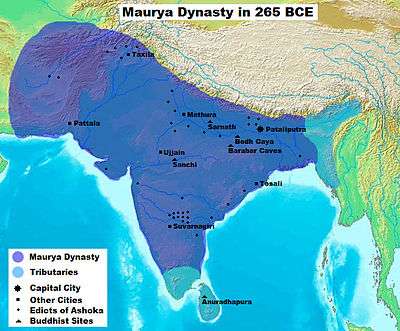
In India, Ashoka ruled the Maurya Empire. The Pandya, Chola and Chera dynasties of the classical age flourished in the ancient Tamil country.

Qin has expanded southwest, Chu north and Zhao northwest
The Warring States period in China drew to a close, with Qin Shi Huang conquering other nation-states and establishing the short-lived Qin dynasty, the first empire of China, which was followed in the same century by the long-lasting Han dynasty. The Protohistoric Period began in the Korean peninsula. The Xiongnu were at the height of their power in Mongolia.
Events
290s BC
- 299 BC: The Samnites, seizing their chance when Rome is engaged on the Lombard plain, start the Third Samnite War with a collection of mercenaries from Gaul and Sabine and Etruscan allies to help them.
- 298 BC: The Samnites defeat the Romans under Lucius Cornelius Scipio Barbatus in the Battle of Camerinum, first battle of the Third Samnite War.
- 293 BC: The Chinese State of Qin reduced the threat of the State of Wei and the State of Han with the Qin victory in the Battle of Yique.
- Roman armies penetrate into the heart of the Samnite territory and then capture the Samnite cities of Taurasia, Bovianum Vetus and Aufidena.
- Agathocles, king of Syracuse, Sicily, assists the Italian Greeks against the Bruttians.
- Ptolemy finally brings the rebellious region of Cyrene under his control. He places the region under the rule of his stepson Magas.
- Bindusara succeeds his father Chandragupta Maurya as emperor of the Mauryan Empire.
- Theater of Epidauros is built (with later additions).
280s BC
- 285 BC: The Pharos of Alexandria is completed.
- 281 BC: Antiochus I Soter, on the assassination of his father Seleucus becomes emperor of the Seleucid empire.
- 281 BC: Achaean League founded in Greece.
- 280 BC: King Pyrrhus of Epirus invades Italy in an attempt to subjugate the Romans and bring Italy under a new empire ruled by himself.
- 280 BC: Construction of the Colossus of Rhodes is completed.
270s BC
- 279 BC: Singidunum and Taurunum, today's Belgrade and Zemun, are founded by Scordisci Celts.
- After failing to decisively defeat the Romans, Pyrrhus of Epirus withdraws from Italy.
- Gallic migration to Macedon, Thrace and Galatia.
- 273 BC – 232 BC: Ashoka the Great ruled the Maurya Empire.
260s BC
- 265 BC: Kalinga War takes place between Ashoka the Great and the kingdom of Kalinga.
- 264 BC: First Punic War breaks out between the Carthaginian Empire and the Roman Republic.
- 261 BC: Antiochus II Theos, 2nd son, at the death of his father becomes emperor of the Seleucid empire.
- 260 BC: Battle of Changping between the State of Qin and the State of Zhao in China; a decisive Qin victory.
- 260 BC: Ashoka inscribes the Edicts of Ashoka.
250s BC
- 258 BC: An Dương Vương overthrows the Hồng Bàng Dynasty in Viet Nam.
- 257 BC: Thục Dynasty takes over Vietnam.
240s BC
- 243 BC: Surprise attack on the Macedonian garrison at Corinth. Expansion of the Achaean League.
- 241 BC: First Punic War ends in Carthaginian defeat. Rome demands large reparations, and annexes Sicily and Corsica.
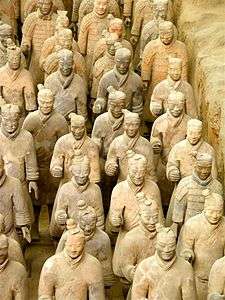
230s BC
220s BC
- 229 BC: The First Illyrian War ends with a Roman victory.
- 229 BC: Last tyrants on the Peloponnese abdicate, Argos joins the Achaean League, Athens liberated from Macedonian garrison.
- 227 BC: The attempted assassination of Ying Zheng (嬴政), king of Qin State, by Jing Ke (荊軻) from Yan failed.
- 225 BC: A large Gallic army is defeated by the Romans at the Battle of Telamon.
- 225 BC: The Chinese Qin State conquers Wei.
- 223 BC: The Chinese Qin State conquers Chu.
- 222 BC: The Chinese Qin State conquers Yan and Zhao.
- 222 BC: Spartan defeat in the Battle of Sellasia ends the Cleomenean War.
- 221 BC: With the conquest of the State of Qi, Qin Shi Huang (秦始皇) unifies the whole of China into one empire that also included northern Vietnam, forming the Qin Dynasty.
210s BC
- 218 BC: Second Punic War begins. Hannibal makes his famous Alpine crossing to invade Italy, the Roman heartland.
- 216 BC: Hannibal famously crushed the Roman legions at the Battle of Cannae.
- 214 BC: Qin Shi Huang (秦始皇) of the Chinese Qin Dynasty ordered construction of the Great Wall of China.
200s BC
- 208 BC: Zhao Tuo (Triệu Đà) defeats the Vietnamese king An Dương Vương.
- 207 BC: Triệu Dynasty of Viet Nam is inaugurated.
- 206 BC – 202 BC: Civil war of the Chu-Han contention in China after the fall of the Qin Dynasty.
- 202 BC: Romans defeat Carthage, ending the Second Punic War. Carthage's territories are reduced to the city itself, and crippling reparations are demanded by Rome.
- Indian traders regularly visit Arabia.
- Scythians occupy Sogdiana, in modern-day Uzbekistan.
- Han Dynasty of China is founded (202 BC–220 AD).
Significant people
Politics and government
- Appius Claudius Caecus, Roman statesman
- Aratus of Sicyon, Greek statesman
- Arsinoe II, co-ruler of Egypt
- Ashoka, Mauryan ruler of India
- Bai Qi (白起), Chinese general
- Bindusara, ruler of the Mauryan Empire
- Diodotus I, first ruler of Greco-Bactrian Kingdom
- Emperor Gaozu of Han (高皇帝), founder of the Han Dynasty in China
- Gaius Lutatius Catulus, Roman general
- Hamilcar Barca, Carthaginian general and politician
- Han Xin, Chinese general
- Hannibal Barca, Carthaginian general and politician
- Hanno the Great, Carthaginian politician
- Hasdrubal Barca, Carthaginian general
- Ilamcetcenni, Cholas ruler of South India
- King Zhaoxiang of Qin, Chinese king of the Qin state
- Lian Po, Chinese general
- Li Bing (李冰), Chinese administrator and engineer
- Li Mu, Chinese general
- Li Si (李斯), Chinese Chancellor of the Qin Dynasty
- Lü Buwei, Chinese merchant and Chancellor of Qin
- Lin Xiangru, Chinese politician
- Mago Barca, Carthaginian general
- Manius Curius Dentatus, Roman general
- Marcus Atilius Regulus, Roman general
- Marcus Claudius Marcellus, Roman general
- Marcus Porcius Cato, Roman statesman and writer
- Masinissa, king of Numidia
- Meng Tian, Chinese general
- Modu Chanyu, Xiongnu chieftain
- Philip V of Macedon, King of Macedonia
- Ptolemy I, pharaoh of Egypt
- Ptolemy II, pharaoh of Egypt
- Pyrrhus of Epirus, King of Epirus
- Publius Cornelius Scipio Africanus, Roman general and politician
- Qin Shi Huang (秦始皇), Chinese Emperor
- Quintus Fabius Maximus Verrucosus, Roman general and politician
- Xanthippus of Carthage, Greek general
- Wang Jian, Chinese general
- Xiang Yu (項羽), Chinese rebel general against the Qin Dynasty
- Xiao He, Chinese statesman and Chancellor of the Han dynasty
- Zhang Liang, Chinese strategist and statesman
- Zhao Tuo, Chinese military commander who conquered the Vietnamese Kingdom of Au Lac
Literature
- Apollonius of Rhodes, Greek poet
- Aratus, Greek poet
- Callimachus, Greek poet and scholar
- Gnaeus Naevius, Roman poet
- Menander, Greek playwright
- Menippus, Greek satirist
- Plautus, Old Latin playwright
- Song Yu (宋玉), Chinese poet
- Theocritus, Greek poet
- Qu Yuan (屈原), Chinese poet and scholar
Science and philosophy
- Apollonius of Perga, Greek mathematician
- Arcesilaus, Greek philosopher
- Archimedes, Greek mathematician, physicist, and engineer
- Aristarchus of Samos, Greek astronomer and mathematician
- Aristyllus, Greek astronomer
- Berossus Hellenistic Babylonian historian and astronomer
- Conon of Samos, Greek astronomer
- Demetrius of Phalerum, Greek philosopher and orator
- Dicaearchus, Greek philosopher and scientist
- Epicurus, Greek philosopher
- Eratosthenes, Greek mathematician, geographer and astronomer
- Euclid, Greek geometer
- Han Fei (韓非), Chinese philosopher
- Manetho, Hellenistic Egyptian historian
- Mencius, Chinese philosopher
- Philo of Byzantium, Greek mechanic
- Pyrrho, Greek philosopher
- Theophrastus, Greek philosopher
- Timon of Phlius, Greek philosopher
- Xun Kuang (荀況, Xun Li), Chinese philosopher
- Zeno of Citium, Greek philosopher
- Zenodotus, Greek grammarian
Inventions, discoveries, introductions
- Eratosthenes accurately calculates diameter of the Earth using Camels and Shadows.
- Weiqi well-established in China, and may date back to the 2nd millennium BC.
- Stone of Canopus (for Ptolemy III), No. 1, in Rosetta Stone Series of 3 stones. Implements leap year in Egypt. Leap year not formally recognized until Caesar in 55 BC.
- 293 BC: first Roman sundial [Pliny (79ce): Natural History 7.213].
- Water screw invented by Archimedes.
- Invention of the musical instrument hydraulis, the precursory to the Pipe organ by Ctesibius, a Greek engineer working in Alexandria.
- Emperor Gaozu of Han China discovers an elaborate mechanical puppet theater in the treasury of the previous ruler Qin Shihuang.
- The enormous Du Jiang Yan Irrigation System of China is engineered and constructed by Li Bing (李冰) in 256 BC.
- Burial chamber, Tomb of the Reliefs, Cerveteri, is made.
- Great Stupa, Sanchi, Madhya Pradesh, India, Maurya period, is founded by King Chandragupta Maurya.
- Silk is exported to Europe from China.
- Armillary spheres, models of objects in the sky developed by the Greeks, are in use as teaching tools.
Sovereign states
Decades and years
| Wikimedia Commons has media related to 3rd century BC. |
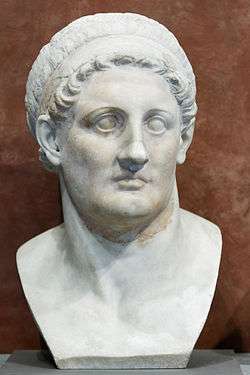
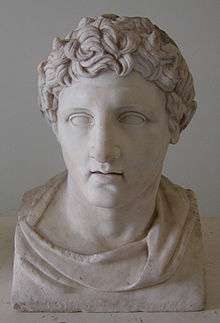
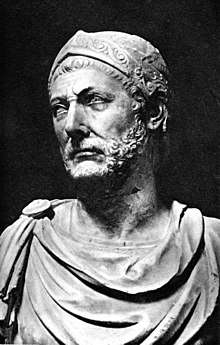
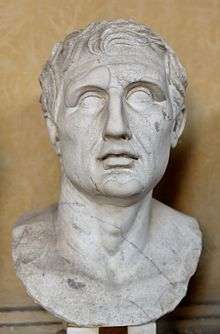
_-_BEIC_6353768.jpg)